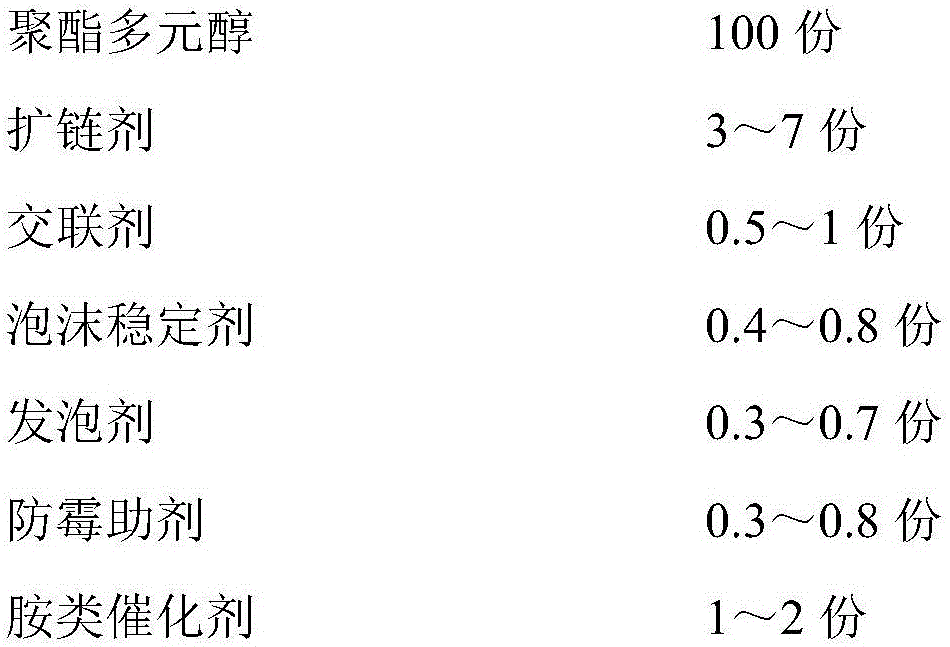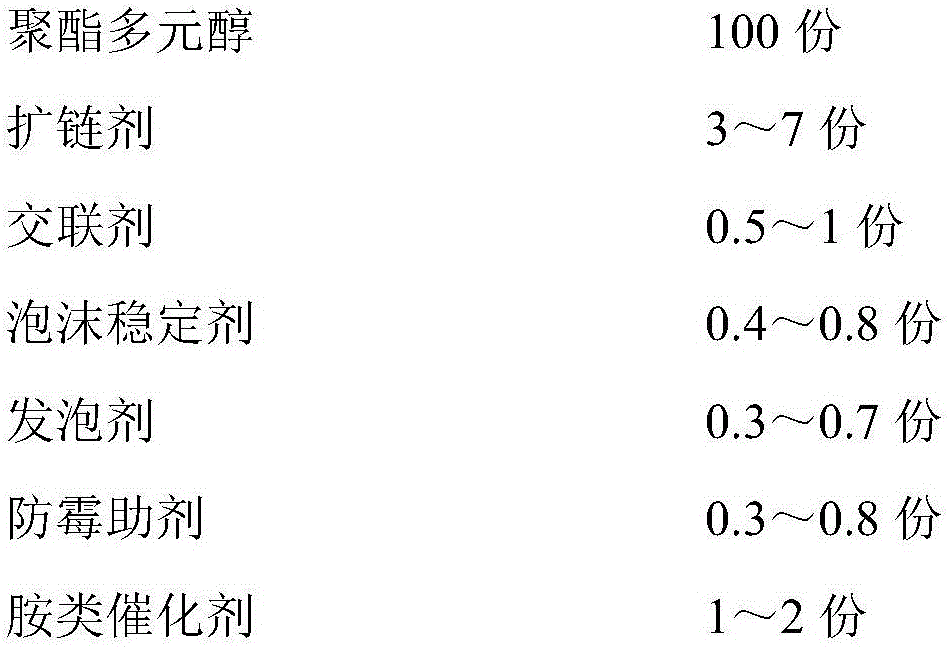Low-density composite material for rapid demoulding shoes
A low-density, demoulding technology, used in applications, shoe soles, insoles, etc., can solve the problems of long mold opening time, low unsaturation, and low production efficiency, and achieve short demoulding time, high production efficiency, and mildew resistance. handy effect
- Summary
- Abstract
- Description
- Claims
- Application Information
AI Technical Summary
Problems solved by technology
Method used
Image
Examples
Embodiment 1
[0034] Component A: Weigh 100 kg of polyester polyol (PE2515, produced by Shandong Yinuowei Polyurethane Co., Ltd.) with a functionality of 2 and a number average molecular weight of 1500, 3 kg of ethylene glycol, and silicone foam stabilizer DC193 (USA Gas Chemical Products Co., Ltd.) 0.3kg, glycerin 0.8kg, water 0.65kg, RHA-DM-3 0.3kg, put the above raw materials in a mixing kettle, after mixing evenly, discharge the material, and seal it for storage;
[0035] Component B: Weigh 40kg of polyether polyol (SD-820, produced by Shanghai Dongda Chemical Co., Ltd.), keep the temperature at 55°C, add 54kg of 4,4-diphenylmethane diisocyanate, 2g of phosphoric acid, and heat up to Insulate and react at 77°C for 1.2h, add 6kg of carbodiimide-modified MDI, stir for 0.5h, take a sample and test, the mass content of -NCO is 19%±0.2, cool down to 40°C and discharge, sealed and stored;
[0036] When in use, add 1kg of ethylene glycol solution with triethylenediamine accounting for 35wt% to...
Embodiment 2
[0038] Component A: Weigh 100 kg of polyester polyol (PE2520, produced by Shandong Yinuowei Polyurethane Co., Ltd.) with a functionality of 2 and a number average molecular weight of 2000, 4 kg of ethylene glycol, and silicone foam stabilizer DC2525 (USA Gas Chemical Products Co., Ltd.) 0.2kg, DC193 0.3kg, diethanolamine 0.5kg, RHA-DM-3 0.4kg, XD-104 0.5kg, water 0.6kg, put the above raw materials in the mixing kettle, after mixing evenly, Discharging, sealed and preserved;
[0039] Component B: Weigh 30kg of polyether polyol (SD-820, produced by Shanghai Dongda Chemical Co., Ltd.), keep the temperature at 55°C, add 60kg of 4,4-diphenylmethane diisocyanate, 3g of phosphoric acid, and heat up to Insulate and react at 77°C for 1.2h, add 10kg of carbodiimide-modified MDI, stir for 0.5h, take a sample and test, the mass content of -NCO is 22.5%±0.2, cool down to 40°C and discharge, sealed and stored;
[0040] When in use, add 2kg of ethylene glycol solution with triethylenediamin...
Embodiment 3
[0042] Component A: Weigh 100 kg of polyester polyol (PE2515, produced by Shandong Yinuowei Polyurethane Co., Ltd.) with a functionality of 2 and a number average molecular weight of 1500, 5 kg of ethylene glycol, 2 kg of diethylene glycol, and silicone Foam stabilizer DC2525 (produced by American Gas Chemical Products Co., Ltd.) 0.6kg, glycerin 0.5kg, RHA-DM-3 0.5kg, XD-104 0.4kg, water 0.5kg, put the above raw materials in a mixing kettle, mix well , discharged, sealed and stored;
[0043] Component B: Weigh 30kg of polyether polyol (SD-820, produced by Shanghai Dongda Chemical Co., Ltd.), SD560118kg, 2g of phosphoric acid, keep the temperature at 55°C, add 58kg of 4,4-diphenylmethane diisocyanate, Heat up to 77°C and keep it warm for 1.2h, add 4kg of carbodiimide-modified MDI, stir for 0.5h, take a sample for detection, the mass content of -NCO is 19.9%±0.2, cool down to 40°C, discharge, and seal it for storage;
[0044] When in use, add 1.2kg of ethylene glycol solution w...
PUM
 Login to View More
Login to View More Abstract
Description
Claims
Application Information
 Login to View More
Login to View More - R&D
- Intellectual Property
- Life Sciences
- Materials
- Tech Scout
- Unparalleled Data Quality
- Higher Quality Content
- 60% Fewer Hallucinations
Browse by: Latest US Patents, China's latest patents, Technical Efficacy Thesaurus, Application Domain, Technology Topic, Popular Technical Reports.
© 2025 PatSnap. All rights reserved.Legal|Privacy policy|Modern Slavery Act Transparency Statement|Sitemap|About US| Contact US: help@patsnap.com


